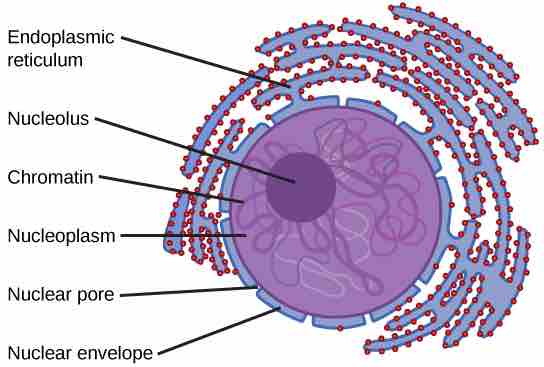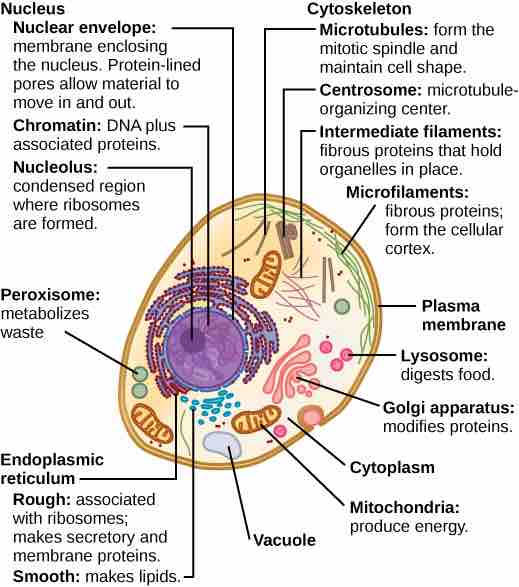Eukaryotic Cell Structure
Like a prokaryotic cell, a eukaryotic cell has a plasma membrane, cytoplasm, and ribosomes. However, unlike prokaryotic cells, eukaryotic cells have:
- a membrane-bound nucleus
- numerous membrane-bound organelles (including the endoplasmic reticulum, Golgi apparatus, chloroplasts, and mitochondria)
- several rod-shaped chromosomes
Because a eukaryotic cell's nucleus is surrounded by a membrane, it is often said to have a "true nucleus. " Organelles (meaning "little organ") have specialized cellular roles, just as the organs of your body have specialized roles. They allow different functions to be compartmentalized in different areas of the cell.
The Nucleus & Its Structures
Typically, the nucleus is the most prominent organelle in a cell. Eukaryotic cells have a true nucleus, which means the cell's DNA is surrounded by a membrane. Therefore, the nucleus houses the cell's DNA and directs the synthesis of proteins and ribosomes, the cellular organelles responsible for protein synthesis. The nuclear envelope is a double-membrane structure that constitutes the outermost portion of the nucleus. Both the inner and outer membranes of the nuclear envelope are phospholipid bilayers. The nuclear envelope is punctuated with pores that control the passage of ions, molecules, and RNA between the nucleoplasm and cytoplasm. The nucleoplasm is the semi-solid fluid inside the nucleus where we find the chromatin and the nucleolus. Furthermore, chromosomes are structures within the nucleus that are made up of DNA, the genetic material. In prokaryotes, DNA is organized into a single circular chromosome. In eukaryotes, chromosomes are linear structures.

Eukaryotic Nucleus
The nucleus stores chromatin (DNA plus proteins) in a gel-like substance called the nucleoplasm.The nucleolus is a condensed region of chromatin where ribosome synthesis occurs.The boundary of the nucleus is called the nuclear envelope.It consists of two phospholipid bilayers: an outer membrane and an inner membrane.The nuclear membrane is continuous with the endoplasmic reticulum.Nuclear pores allow substances to enter and exit the nucleus.
Other Membrane-Bound Organelles
Mitochondria are oval-shaped, double membrane organelles that have their own ribosomes and DNA. These organelles are often called the "energy factories" of a cell because they are responsible for making adenosine triphosphate (ATP), the cell's main energy-carrying molecule. Mitochondria are also important in cellular respiration. The endoplasmic reticulum modifies proteins and synthesizes lipids, while the golgi apparatus is where the sorting, tagging, packaging, and distribution of lipids and proteins takes place. Peroxisomes are small, round organelles enclosed by single membranes; they carry out oxidation reactions that break down fatty acids and amino acids. Peroxisomes also detoxify many poisons that may enter the body. Vesicles and vacuoles are membrane-bound sacs that function in storage and transport. Other than the fact that vacuoles are somewhat larger than vesicles, there is a very subtle distinction between them: the membranes of vesicles can fuse with either the plasma membrane or other membrane systems within the cell. All of these organelles are found in each and every eukaryotic cell.
Animal Cells Versus Plant Cells
While all eukaryotic cells contain the aforementioned organelles and structures, there are some striking differences between animal and plant cells. Animal cells have a centrosome and lysosomes, whereas plant cells do not. The centrosome is a microtubule-organizing center found near the nuclei of animal cells while lysosomes take care of the cell's digestive process.

Animal Cells
Despite their fundamental similarities, there are some striking differences between animal and plant cells.Animal cells have centrioles, centrosomes, and lysosomes, whereas plant cells do not.
In addition, plant cells have a cell wall, a large central vacuole, chloroplasts, and other specialized plastids, whereas animal cells do not. The cell wall protects the cell, provides structural support, and gives shape to the cell while the central vacuole plays a key role in regulating the cell's concentration of water in changing environmental conditions. Chloroplasts are the organelles that carry out photosynthesis.

Plant Cells
Plant cells have a cell wall, chloroplasts, plasmodesmata, and plastids used for storage, and a large central vacuole, whereas animal cells do not.